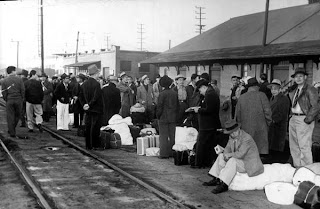Just about midway between
B & W photos from OAC - online archives of California
By unofficial count, there are twelve landmarks throughout the state that deal the relocation of those of Japanese ancestry during World War II. All but this one were detention and transfer centers that collected and sent innocent and patriotic people to this desolate concentration camp known as Manzanar and nine others further inland throughout the country. Manzanar too was originally a temporary facility, and thus also has the ‘#934’ landmark designation of the other temporary detention centers in
In those dark days following the attack on Pearl Harbor the pretzel logic thinking of the powers that be felt that a few in the US Japanese population could act in similar fashion to what was recent experience with gang elements of Japanese living in Brazil and develop or already have ties to their homeland and Germany for the purpose of spying and espionage. But that’s a faint excuse to the core of an act that was simply racism, giving little or no thought to the detention of those of German ancestry. The injustice of this on a personal level was realized years ago in the mid 1970’s living in
Most people imprisoned here said the hardest thing to endure was lack of privacy. Entire families confined to a 20’ x 25’ tent, and common latrines and showers. When the war ended they were given $25 and a one-way bus or rail ticket and told to leave, yet many had lost everything and had no place to go.
Plaque inscription: No. 850 Manzanar
In the early part of World War II, 110,000 persons of Japanese ancestry were interned in relocation centers by executive order no. 9066, issued on February 19, 1942.
Manzanar, the first of ten such concentration camps, was rounded by barbed wire and guard towers, confining 10,000 persons, the majority being American citizens.
May the injustices and humiliation suffered here as a result of hysteria, racism, and economic exploitation never emerge again
200 ft W of Hwy 395 (PM 67.3), 9.6 mi N of Lone Pine.
Google: 36.727637,-118.147917
Photo - national historic site marker
(no plaque) Plaque Inscription: No. 934 Manzanar
The temporary detention camps (also known as 'assembly centers') represent the first phase of the mass incarceration of 97,785 Californians of Japanese ancestry during World War II. Pursuant to Executive Order 9066 signed by President Franklin D. Roosevelt on February 19, 1942, thirteen makeshift detention facilities were constructed at various
Google: 36.727465,-118.147402









No comments:
Post a Comment